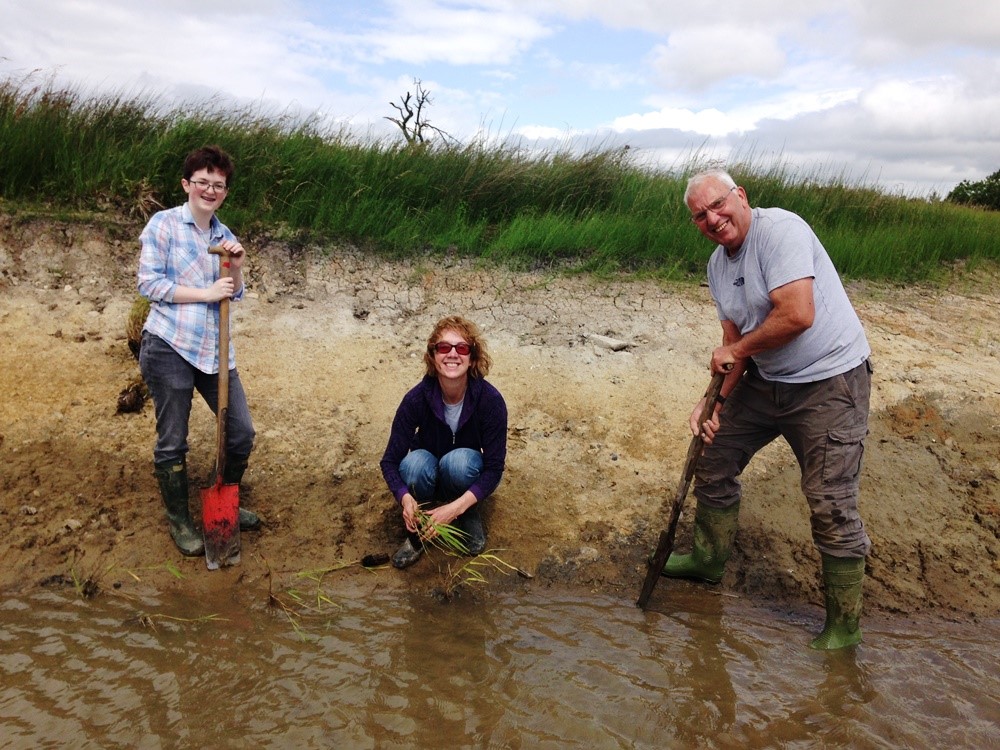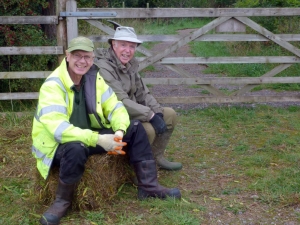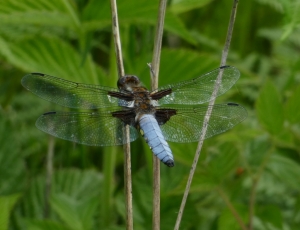Blog Archive (28) Posts Made in September 2016
What’s in the Box?!
Friday, September 30th 2016
This afternoon we started checking our bat boxes with help from members of local Bat Groups and some of our volunteers. Thank you to all!
One of our finds was this common pipistrelle, Pipistrellus pipistrellus – he (yes, it was a he!) could be identified in the hand as a common rather than a soprano pipistrelle, Pipistrellus pygmaeus, by his wing venation and the colour of his buccal glands (cheek pouches).
These two species of pipistrelle were only identified as being separate species in the 1990s, with the easiest way to tell them apart being through their echolocation calls; the common pipistrelle typically having a peak echolocation frequency of around 45kHz and the soprano pipistrelle at around 55kHz.
Bat boxes are also sometimes used by species other than bats – a dramatic find being this (beautiful) old wasp nest which had completely filled the box!
If you want to find out more about bats try the Bat Conservation Trust's website at: http://www.bats.org.uk/
Wind, Wet and Pond Snails
Thursday, September 29th 2016
It was strange not having Stacey with us to start the day…. as stated in the previous blog she will soon be heading South with the British Antarctic Survey to study Penguins. We wish her all the best and thank her for her hard work and friendship . I will put links to her blog, and other links regarding her work in the near future. We hope she will return safely next year as she is part of our Foxglove Covert family. Stacey, thank you!
The day started sunny but blustery so we had a quick check to ensure there were no trees down then straight on with the tasks of the day. The morning was filled with a variety of tasks; Keith did a few maintenance jobs in the work shop before finishing off the painting of the Portacabin, a few folk went up to the Grand Fir to rake up previously cut grasses and pulling gorse, while John and I repaired boardwalks and went to look at other pending job requirements.
After lunch the team put their survey hats on and made their way to the Wetland to start our yearly pond snail survey.The weather was not ideal, and a few heavy showers came our way.
The snail we were keen to find was the Mud Snail, which thankfully we found in a number of the ponds.
This nationally scarce distinctively elongate pond snail, is closely associated with pools and pond margins in agriculturally-unimproved habitats, typically on historic Commons.
The global population was recently estimated to have declined by 20-25% over 15 years with a 25-49% decline in Great Britain during the period 1985-2010. It is scarce and declining in most parts of its limited global range (Mud Snail is restricted to Western Europe) and has become extinct in Ireland and Poland.
We also found plenty of immature Smooth or Palmate newts, but at this age we were unable to pin point which was which.
Thank you to all the volunteers for their hard work today, wet but happy!
Migrating South
Wednesday, September 28th 2016
After another summer at Foxglove, the autumn is upon us and the time has come for me to head South back to the Antarctic for the winter. Yesterday and today have involved lots of eating cake and lots of farewells and good wishes. I have had another enjoyable summer at Foxglove, and will no doubt see many of you again before I go or in the Springtime. Thank you all for welcoming me back in the spring and working with me through the summer. At lunchtime yesterday, I concluded my summer with a presentation on penguins and my work in Antarctica (apologies for the slightly fuzzy picture, it was rather dark).
This morning we led a walk around the reserve for the Richmond Walking and Book Festival. This was very enjoyable as we walked right round the reserve, covering a lot more ground than in a usual guided walk.
It was also a good chance to check that no trees had fallen down in the recent strong winds, which luckily they had not. We found more nice fungi whilst in the woodland, including this Oyster mushroom.
After lunch, we headed out onto the wetland to check for one of our rare ferns, a tiny little plant called Pillwort.
We were pleased to find this was not only growing well but was in actual fact spreading to new areas.
Fungi and Tree Removing
Tuesday, September 27th 2016
The Tuesday Volunteers had a busy day. Colin set to work edging the paths around the field centre which now looks much tidier.
The rest of the volunteers headed down the scrapes to remove small sapling trees from the area. Some of them had quite large roots and took a lot of manpower.
Elsewhere on the reserve the Dales School helped out by raking up the rest of the hay that still needed to be removed.
This was then loaded into the trailer and carted away. Some strimming was also done and the feeders filled. At lunchtime Stacey gave a presentation about her penguin work in Antarctica as this is her last week with us.
Whilst out and about we found some lovely fungi today, the different colours and shapes are incredible. Here are just a few of them. This is Coral Tuft.
This is Candle Snuff.
This is Common Puffball.
And finally, Scarlet Waxcap.
Thanks to everyone who helped out today. We achieved a lot.
Birds, Voles and Schools
Monday, September 26th 2016
This was not the standard Monday morning; I had very little time in the office doing the usual Monday morning routine and busied myself with getting ready for a school education visit by Queen Mary’s School, Thirsk. This was the first visit by the school to the reserve.
The first activity featured birds. While I gave a general presentation on our feathered friends, Stacey and Jenny set up a mist net in the garden in readiness for giving a bird ringing demonstration to the small group of 14. With the birds extracted from the net we were able to show the girls a number of Siskins, Chaffinches, and Blue Tits. The joy on the faces of these young people of being able to get up close to these beautiful birds made all the preparation worth it, and I am sure the memory of this will stay with these young girls way into adulthood, hopefully we have sown a seed for a future Foxglove Covert Reserve Manager.
Below, one of the juvenile male Siskins.
It was not just the children who enjoyed themselves; the teachers themselves also appreciated their time here.
During the habitat walk I set up the bird spotting scope in the Wetland Hide where the Water Voles were seen close-up, and also having another little territorial fight with another Water Vole for the freshly put out apples. The Dexter cows were grazing nearby oblivious to the voles interaction.
With the beginning of Autumn yesterday the weather felt cooler, and the flower meadow devoid of flowers seemed to underline that summer was at an end. However, there is still Scabious and Fleabane about, amongst others.
Plants of Autumn
Sunday, September 25th 2016
There are still many species of flowers in bloom across the reserve, but not in the numbers as two weeks ago. Fewer Cinnabar moth caterpillars has meant Ragwort is still looking pristine, rather than chewed back to its stalks.

Honeysuckle provides food for a variety of insects throughout its flowering time, including this hoverfly.

Blackberries are still in flower.

And in fruit, which are being enjoyed by small mammals and birds. Water Voles have been known to enjoy them, so a task for next week is to collect some for their platforms and see if they still do.

Autumn is of course the time for fungi to appear. This is one of the ink caps.

Bright colours were seen and upon investigation it was a fungus.

Under the canopy along Risedale Beck someone has been busy with needle and thread, stitching a neat running stitch around the cap of these fungi!!

A Special Eco Club
Saturday, September 24th 2016
On arrival the wind was blowing fit to bring down the conifers! This was not good as Eco Club was heading to the ringing room for a ringing demonstration. Weather forecasts were checked and double checked and obviously the weather had not read them! Whilst we sat comfortably and had a cup of tea, and of course discussed the weather, the wind dropped considerably so some nets were opened.
The bird ringers showed the children how the birds were ringed and what was involved.
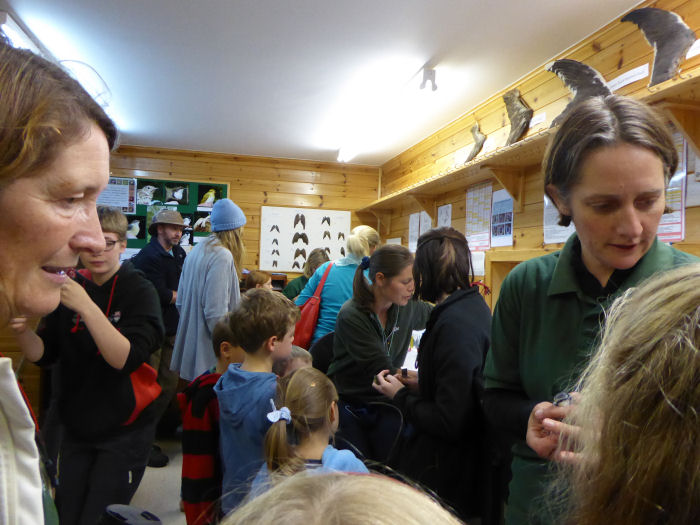
They were able to see how the wing was measured and how the birds were weighed.
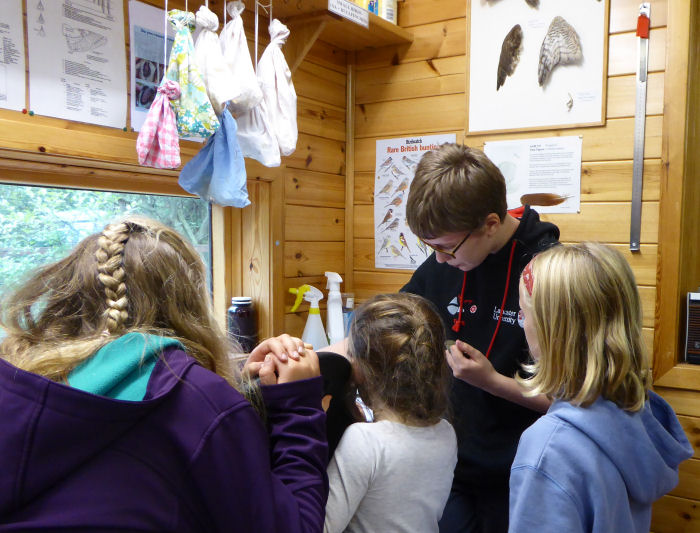
Using a fluffy toy bird, the children saw how the birds were caught in the net and learned the difference between residents and migrants
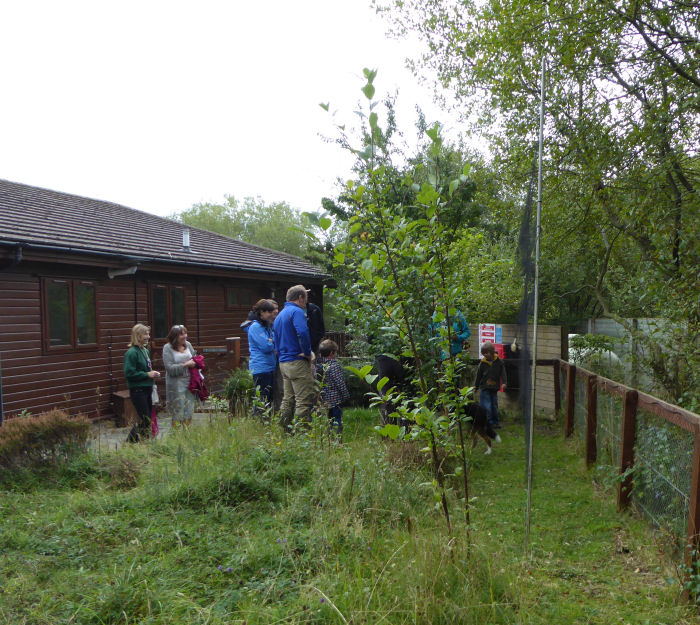
A huge thank you to all the volunteers involved this morning, making it a very special occasion for the children who were fascinated to see the birds close up.
Although only a few nets were used, it was an interesting list of species recorded. Our first Redpolls of the autumn were ringed. There were several Siskin, Goldfinch and Goldcrest caught. A five year old Coal Tit was noted. Chiffchaffs can visit the ringing room into the beginning of October and one was caught today. However it is very rare that a Garden Warbler is still around at this time of year, but a juvenile was processed.
Usually we only ever show photographs of birds in the hand in pristine plumage, but in Aug/Sep the last few species are moulting and don't look their best. This juvenile Bullfinch is moulting into his adult plumage. You can see the reddish feathers on his breast and around his beak. His black head feathers are also begining to show. Today's session took the number of new birds ringed in the reserve to over 57,000, and using the current cost of rings we have spent £2395 on Chaffinch rings alone! None of this money has come from the Foxglove fund.
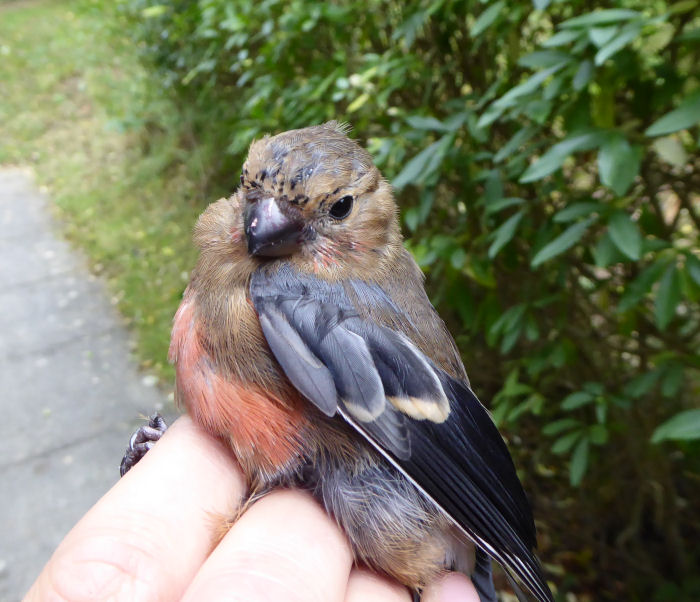
Raking and Aching
Friday, September 23rd 2016
It was a fairly calendar clear day on the reserve today which enabled us to tick a few jobs off the ever growing job list. While Jennifer checked the locations of our bat boxes for a bat survey next week , Stacey and myself took the ATV and trailer onto the patch of grass above Plovers Pool to rake off the grass we had rowed up yesterday. This was a long, tiring and laborious task, and had us reflecting on by- gone-days when the hay cut was always cleared with the use of rakes.
We were pleased to still have the 40 Swaledale Sheep on the Moorland, and they appeared fairly content with the new grazing we had provided.
Whilst wandering over the top moor I found these mating slugs. Slugs are hermaphrodites, having both male and female reproductive organs. They can reproduce without mating, but it was interesting to see these two entwined. I believe these are Arion rufus or Red Slugs. The slug on the left is showing its breathing hole.
There are still a fair few flowers about, but some are looking passed their best. Numerous Bumblebees sat sluggishly on the Scabious, their season is also closing. This one is a Miner Bumblebee.
A young person who attended the site recently wanted fellow young birders to check out a birding site which he found of use http://www.homeadvisor.com/r/birdwatching-guide/
For all you natural history photographers, check out the events page on this site for our photography competition.
A Sunny Thursday
Thursday, September 22nd 2016
Today dawned bright and sunny but breezy. The volunteers spent a large part of the day out on the hay meadow by Plovers' Pool, raking up all the grass that had been cut.
This field contains quite a lot of gorse so the farmers who baled and took the rest of the hay did not want it for their animals. However, they were happy to cut it and leave it lying in the fields, leaving us the task of clearing it. By the end of the day it was all neatly raked into rows. We will leave it a couple of days now to dry off as it is very wet and heavy to move.
Elsewhere on the reserve, John set to work on the wetland fixing a leak in one of the bunds that was causing us to lose a lot of water out across the reserve. From time to time our water voles dig through the bunds, rerouting our water supplies to less helpful places. After some investigation, the underwater tunnel was refilled and the problem solved. Meanwhile, Keith fixed the window in one of the hides and took advantage of the dry weather to continue painting the portacabin. While the volunteers were hard at work, Elizabeth led a guided walk around the reserve which was well attended.
Last night our 40 Swaledale sheep arrived.
They have free range of the hay meadow, around Plovers' Pool and all the way up to the Stone Circle. They were released into the middle moor and rapidly moved over into the next field. I think they were a bit disappointed by how short the newly mown grass was!
The moth trap yesterday revealed a couple of rather nice moths. Close up they are quite pretty to look at. This is a Frosted Orange.
And this is a Canary Shouldered Thorn. Usually the male moths are the ones with the largest antennae as they use these to detect the pheromones given off by the female moths to help them locate a mate.
Thanks to the volunteers for all their hard work with the various tasks today.
A Small Miracle
Wednesday, September 21st 2016
We have many groups of young people come to visit us and we run exciting activities for them to help them enjoy and learn about Foxglove and our wildlife. A firm favourite is pond dipping, as enjoyed by Northallerton Beavers recently.
We ask that our visiting groups of young people are quiet as they go around in an effort to help them to see some of our shyer and more elusive wildlife and sometimes small miracles happen and the wildlife comes out:
A real treat for the Northallerton Beavers to see a water vole close up!
In other news: Today we cleared scrub at the Scrapes, got the area around Plover’s Pool cut and we started raking. Roger also strimmed to clear the area where most of our early purple orchids grow ready for the spring. And we now have sheep to graze the wildflower meadow! More details to come tomorrow!
A Mixture of Jobs
Tuesday, September 20th 2016
Today was Tuesday. Tuesday as always, means volunteer day, when we get lots of useful outdoor tasks done. Today was no exception. Everyone was relieved to hear that we were not going to pull trees on the heath as we have done for the last few weeks so set to work with enthusiasm. The day largely revolved around the hay meadows. John and Eddie strimmed some footpaths, the smaller hay meadows on the reserve, and then continued the rather large task of strimming round the very edge of our large hay meadow, clearing the bits that yesterday’s tractor couldn’t reach.
Meanwhile other volunteers (too numerous to name individually) raked up the hay from the smaller meadows and cleared some small trees that were threatening to turn our meadows into woodlands!
The Dales School are now back at Foxglove on Tuesdays, as their summer holidays are over. Today they helped out by cutting back gorse bushes near the outdoor classroom.
Elsewhere on the reserve, Ron and John strimmed the net rides, because despite the major CES bird ringing programme being complete for this year, the normal bird ringing continues through the winter, and the grass seems to be showing no sign of stopping growing. Bob and Anne spent some time weeding the back garden, filling bird feeders, and weighing out the bird seed into smaller bags to be sold in the field centre.
Finally we took advantage of the sunny weather to continue painting the portacabin. It is looking rather smart with its new brighter green coat.
We achieved huge amounts today. Thanks very much indeed to all the volunteers who helped out. Without your hard work none of this would be possible.
Bodgers and Baling
Monday, September 19th 2016
The weekend was dominated by Meadow Pipit ringing, and also the late cut of the wild flower meadow. The meadow needs to be cut once a year, and preferably earlier than mid-September.
Sometimes when our farmer friends are in the middle of their own work we have to delay a cut to fit in with them, or wet weather holds us back. The reason we cut and do not leave the sward ‘as is’, is to encourage the various wild flowers to grow next year. If we left the grass long we would lose a lot of the varieties and have choked grasses of limited stature. By cutting we are mimicking the grazing of animals, and encouraging diversity of species on the pasture.
The large bales this year will be taken away and used as stock feed in the form of silage. If it had been cut before the damp September mornings the bales could have been used as hay, but alas the temperature has dropped, and dampness has increased as the year rolls on toward autumn. Also, as this is to be used as silage the turn-a-round from cut to baling is a lot shorter as moisture content is not so important with silage, but hay needs turning and dampless days for quality hay.
Today the baler arrived, leaving deposit of 18 large round bales ready to be carted away later this evening.
Just after the baler had gone we set about tidying up the headlands with the strimmers, ready to be cleared tomorrow with our volunteers.
As I said before the bales are to be made into silage which means the bales are wrapped in black plastic to seal in the grasses plus other herbage. Then due to natural bacterial action the grasses, etc. are pickled and preserved for stock, such as cows, to consume during winter.
We also had the Foxglove Covert Bodgers on site yesterday, these traditional wood workers demonstrate to visitors their various skills. They will be present on site every third Sunday of the month. Next month they will be set up near the Field Centre for members of the public to 'have-a-go', as well as demonstrating with use of a mobile forge, knife making.
Thank you to Ian who did a splendid job with the silage baling/cutting.
More Mipits
Sunday, September 18th 2016
As readers of the blog know the Mipit Season starts around the end of August and continues on to the beginning of October. The number of days we can ring at the Crater is heavily dependent on the weather. We have had two full days ringing already with almost perfect conditions. Today was not quite as good as the wind was a little stronger than forecast, but nearly 200 Meadow Pipts were ringed and some Goldfinch and Reed Buntings also appeared in the mist nets. Another Whitethroat was processed which is an unusual species for the Crater. We caught three birds that had been processed on previous days.
On arrival, the nets were raised to a beautiful sunrise,

which became more impressive as the sun rose.

We also had moonset! The moon was reflected in the pool where the Mipits can be seen drinking..

Net rounds were, as always, carried out regularly.

Sitting at the ringing station, other birds can be seen flying around. Buzzards soar on the thermals, Snipe flew over calling, and Skylark also made an appearance. These geese, possibly Canada, flew over in typical v-shape formation, before the photograph could be taken!

It was another busy day and thanks go to the ringers who helped.
Snippets
Saturday, September 17th 2016
There have been many sightings of Painted Lady Butterflies feeding on the late summer flowers. This one was moving quite quickly as it fed on Hemp Agrimony.

These butterflies migrate to Britain, sometimes in large numbers, from south west Europe and North Africa. Those that arrive early in the year may well breed, giving rise to a second generation on the wing in September and October. They are unable to survive the cold and damp of our winters, even in a pupa stage.

The tree in the lake is well used and this (hopefully I have the correct ID!) juvenile Moorhen was enjoying keeping its feeet dry!

At the lower end of the Crater is a large pond and the House Martins and some Swallows were drinking. These birds are some of the last to be migrating.


We were very lucky to catch a juvenile House Martin and we were all surprised at its 'fluffy' legs and feet! They remained flying around catching insects, of which there were plenty, for the morning and then disappeared!

Autumn
Friday, September 16th 2016
We have had some mixed weather recently. Yesterday started off damp and foggy. Some of the bird ringers spent the entire day ringing meadow pipits and watched the day develop from a cold foggy start, through a hot and sunny day, then finally watched the sun disappear back into an autumnal bank of fog again in the evening.
At Foxglove today, the day started with pouring rain and more fog. Colin braved the weather to fill the bird feeders, for which we are very grateful, while the reserve managers took the opportunity to catch up on some indoor tasks. Later it brightened up and we headed out to do a few outdoor tasks. Whilst out I couldn’t help notice that autumn really seems to be on the way. Here are a few pictures to show this.
The Hawthorn berries have turned a lovely red.
Many of the Blackberries are now ripe.
The orchard has now been strimmed and the grass raked off, so is no longer showing the colours of a summer meadow and instead looks rather bare.
In the orchard itself, the Pears are ripening.
Some of the Apples are already ripe and have started to become dinner for some of our birds. Once the birds have broken the skin, this opens up the apples to a whole host of creatures including this Wasp.
The Beech trees are just starting to change colour.
I always think these are some of the prettiest autumn trees as each branch changes so neatly, every leaf in the correct order from green through to brown, from tip to trunk.
Blue Skies
Thursday, September 15th 2016
It’s been a beautiful day to be outside today, perhaps sitting in the shade with a cool drink and/or a book. It’s also been a beautiful, but hot and sweaty, day to be outside strimming and raking in our meadows, checking water levels and giving some TLC to one of our hides! Thank you to all who helped today under the clear blue skies.
In other news: Calling all Photographers…
The Foxglove Covert Local Nature Reserve (LNR) Calendar has come to take a regular place on many of our walls and it’s a great way to support the reserve. This year we are holding a competition to find amazing photos for next year’s calendar.
The photos should be taken on the reserve at Foxglove Covert LNR or on the surrounding moorland. We will be choosing 12 landscape format photographs to be used in the calendar, illustrating the season and/or showing some wildlife. We will also be looking for a suitable portrait format photo for the front cover.
In addition to having your photos in the calendar, there will be a prize for the photos which the judges consider to be Best Adult photo and Best Child photo (16 years and under).
Please submit your photos as prints (minimum 6” x 4”) in an envelope marked “Calendar Competition” to the Foxglove Office (in the Field Centre), by post to Foxglove Covert LNR, Wathgill Camp, Downholme, Richmond, North Yorkshire, DL11 6AH or email to foxglovelnr@btinternet.com with a file size of between 1MB and 4MB and the subject line ‘Calendar Competition’ by FRIDAY 21ST OCTOBER 2016.
The competition is open to everyone. Please include a title and location for your photo (s), your name, contact details including a phone number and your age if 16 years or under. You can enter as many photos as you like as long as you are happy for your photo(s) to be used in the Foxglove Covert LNR Calendar and any associated publicity. All photographers will be credited. For full terms and conditions email foxglovelnr@btinternet.com.
I reckon you can do better than this photo I took today of a charismatic subject, but out of focus!
Misty Magic
Wednesday, September 14th 2016
It’s been a damp and misty day at Foxglove today – making it perfect for viewing cobwebs…
…and getting slugs out and about.
Why not try coming in weather like this to get photos for our photo competition?
I think the woods to the south of Risedale Beck (on our ‘green route’) are beautiful at any time of the year, but I particularly liked the contrast in light through our ‘magic tree’ today.
Amongst some odds and ends we’ve been busy today with some bracken bashing…
…levelling paving slabs, tidying in the garden and pulling more scrub on the heath.
I also got very excited to find evidence of one of our bat boxes in use when I found these bat droppings underneath (finger shown for scale)!
A Variety of Tasks
Tuesday, September 13th 2016
Today at Foxglove it was incredibly hot. However, our volunteers set to work as usual, once again on the heath, continuing the seemingly never ending task of pulling up encroaching tree saplings.
Where possible this is done with tree poppers, which lever small trees out of the ground. The problem we have is that in the past we have often pruned these rather than pulling them out at the roots so we are left with a giant lump of root and stems that is very difficult to remove. Many of these have to be dug out by hand to prevent them growing back again next year.
Whilst working out in the mini heatwave we found some nice creatures including this large Toad.
And this Pink-Barred Sallow Moth.
Ken and Eddie spent the morning strimming. Today they had a bit of variety- instead of the usual strimming of edges of pathways they strimmed the garden, then moved on to strimming the orchards.
The Orchards are like hay meadows and have not yet been cut at all this year to allow the orchids and other flowers to seed. The next job will be to rake up the hay before it has a chance to rot down, keeping the soil fairly nutrient poor to allow the flowers to grow in preference to the grasses. After lunch we all had a break from physical work and took a look into the past with Tony, who did a talk and slide show of the reserve from its early days.
It was incredible to see how the reserve has developed over time from its small beginnings to the reserve and field centre we are lucky enough to have today. Thanks very much to Tony for his presentation, and to the volunteers for all their help.
Monday Checks
Monday, September 12th 2016
It was a typical start to the week, office work then out, especially as the weather was bright and sunny.
Doing the various checks of the water levels on the Wetland, cow checks, and apples placed on the Water Vole rafts I noticed Water Crickets moving rapidly over the surface of the outlets.
These small pond skater like bugs are present in a lot of the flowing streams, the above is an adult, which stopped long enough to allow me to take this pic. There are two varieties of Water Cricket in the UK, this one is 6.5 mm called Velia caprai. The below photo is of a Freshwater Shrimp from the same slow moving stream. The flow of water has been reduced due to the lack of rain recently, hence all the checks of water levels.
These Common Darters were sat in the sun on the Moorland path.
In the damp of the woodland along Risedale Beck we noticed this fairly young Sulphur Tuft.
Out of the Ordinary
Sunday, September 11th 2016
It is the Mipit season so of course the weather forecast is usually for wind and rain, cold and the first frosts. Not quite as bad recently, only very strong winds, which is not good when you are on top of the world! Tony, who watches the forecast with eagle eyes, spotted a break in the weather so a late email called those ringers that could, to meet at the Crater at 6am on Saturday.
It was a small team that raised the nets and installed the new speaker lures. As soon as this one was switched on the Mipits appeared from every direction.
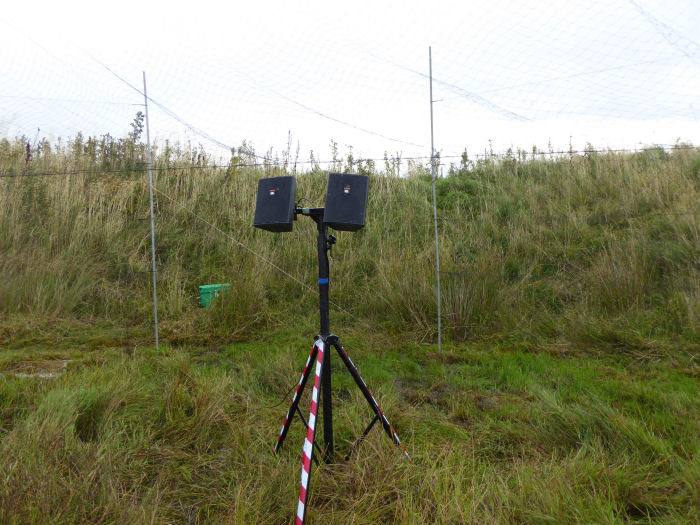
Although some preferred to hide in the undergrowth.
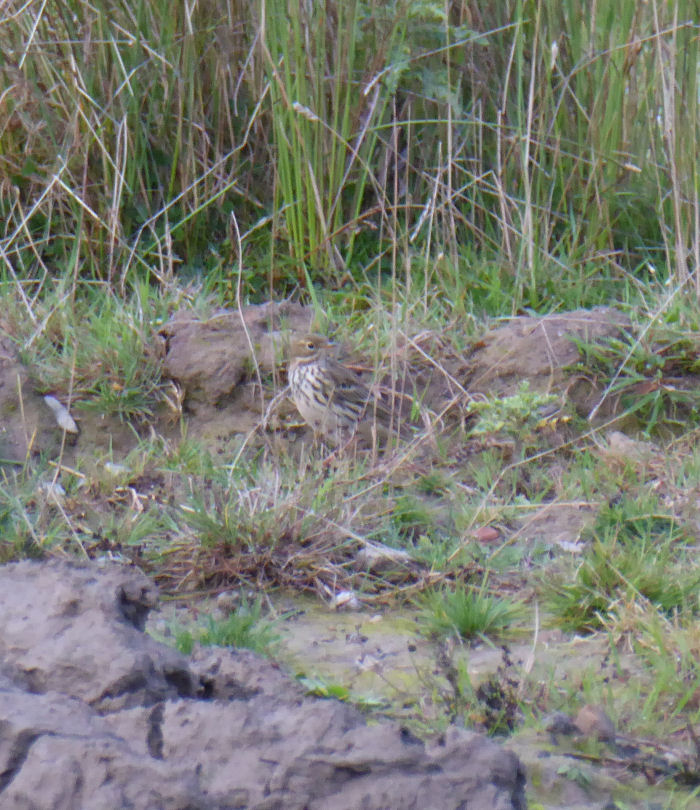
Net rounds returned many birds, by lunch time numbers usually decrease but no, they still kept coming.
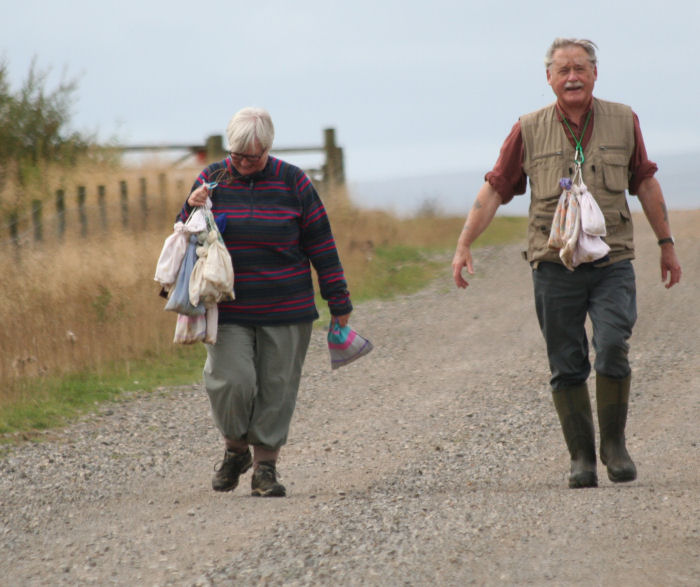
As the day moved on there were some beautiful cloud formations.
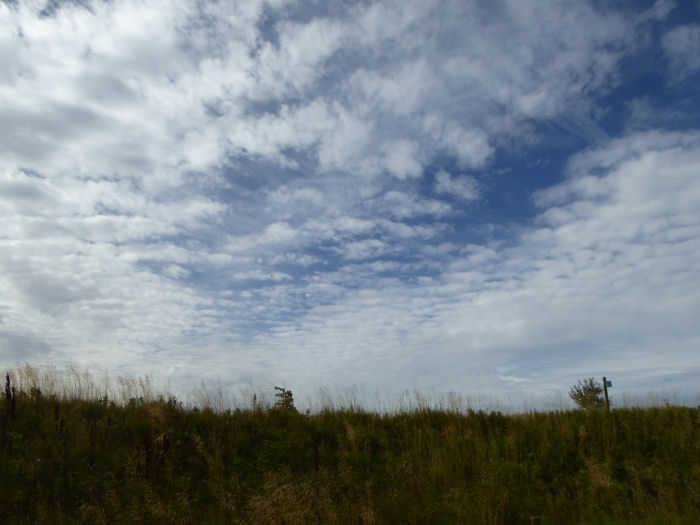
Whilst ringing this larger bird was spotted and it was a Green Woodpecker as can easily be seen by this 'brilliant' photograph!
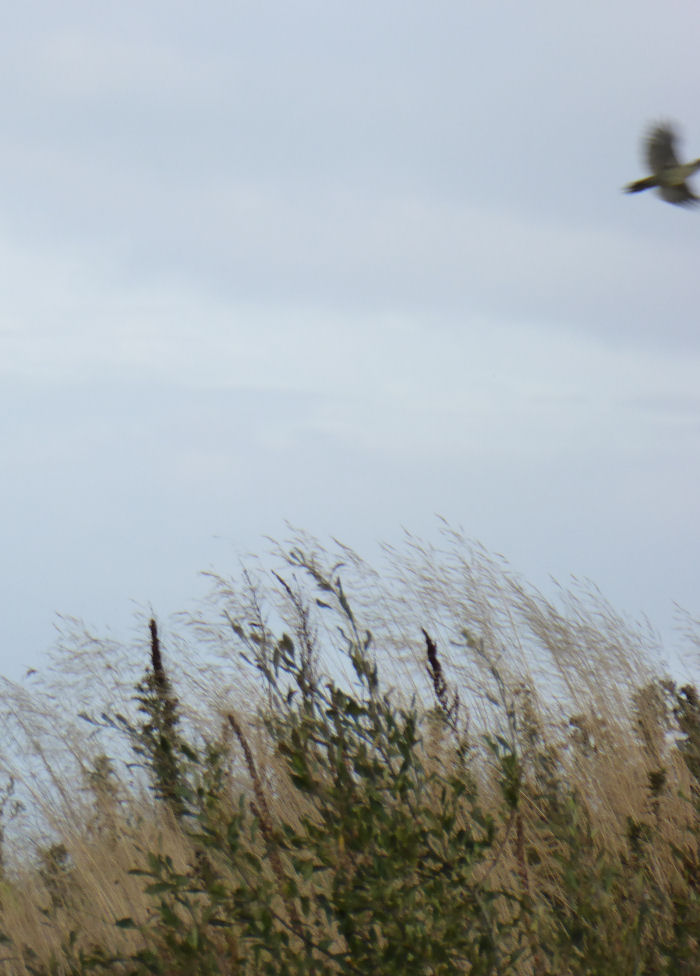
The majority of the birds caught were Meadow Pipits but Reed Bunting, Goldfinch, Wren and Sparrowhawk all put in an appearance, as did this juvenile Linnet. It was just starting to moult and show its red breast feathers.
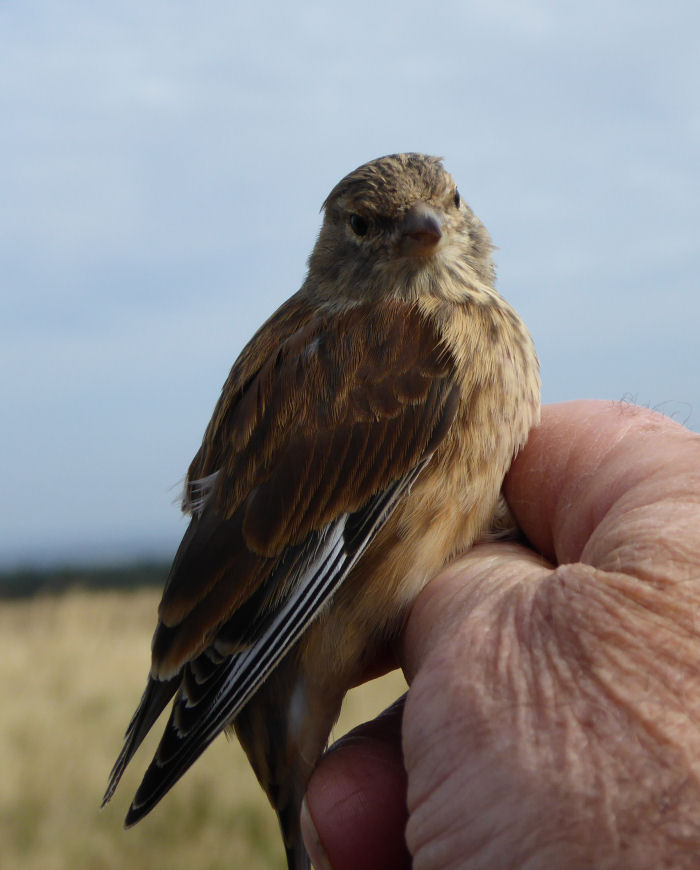
There was no lull in the birds coming through and the ringers, Tony, Roger, Jenny and Sophie were kept very busy. New strings of 100 rings, were repeatedly put on the table and used.
Birds were still being caught late in the aftenoon, which is very unusual. It was also noticeable that slightly older birds, those in post juvenile moult were caught in the morning, whilst as the day progressed it was younger birds that were coming through.
We can often see a sunrise at the Crater and some are spectacular, but we have never before watched the sun beginning to set.
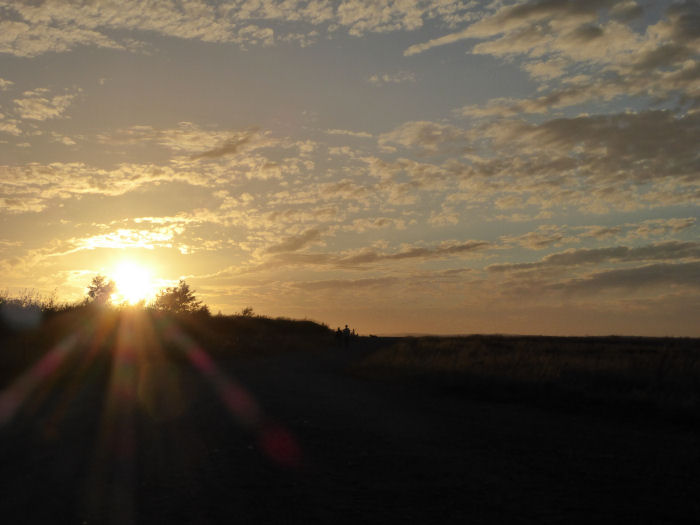
Nor have we seen the moon rise!
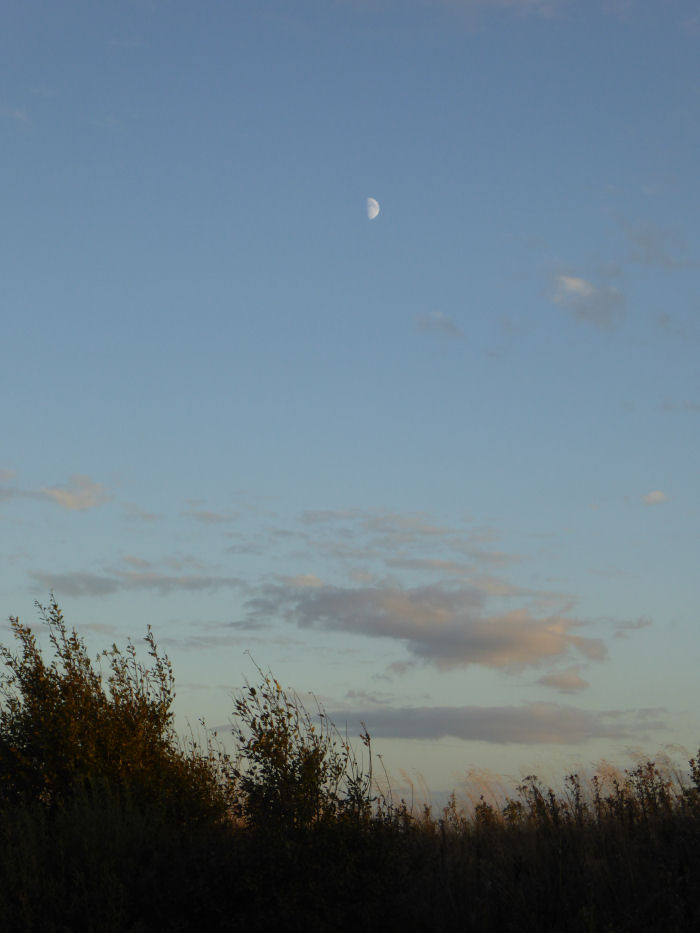
The nets were finally taken down and all the kit was returned to its particular place in cars and landrover.
The small team of ringers left to a glorious sunset.
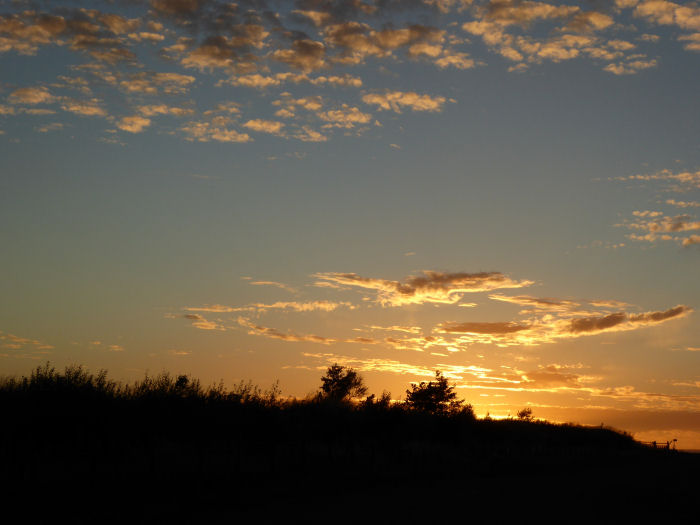
Tony's comment at the end of the day “I never like to over egg what we do but that was indeed out of the ordinary! I would be surprised if any of us ever witness a day like it ever again!”
Why was it out of the ordinary? The weather was perfect, no wind, not too hot, and sunny. Over 500 birds were ringed during the day. The weight of the Mipits ranged from 14.8g to 19.8g which is only 5g difference between over 500 birds. Some birds were just beginning to lay down fat, ready for their long migration south. The BTO collate all this data and it enables them to look at trends in our bird populations.
It was a very special day, quite out of the ordinary. Thanks go to the ringers who worked tirelessly throughout and to Glennis and Joan who delivered sausage rolls to the top of the world!
Thanks go also to Sandra, her daughter Jade, Ruth, Ann and the others involved in the Car Boot Sale who very kindly spent the day at Bedale raising over £200 for the reserve - a sterling effort by everyone!
Lots of action (including on camera)!
Saturday, September 10th 2016
There’s been so much going on today – and photos and details haven’t all reached me yet – so I’ll come back to exciting bits of it at a later date! We’ve had a stall at the Bedale car boot sale, have had a Beavers group and Goosemoor Nature Reserve visit Foxglove as well as getting some more scrub cleared on the wetland, Brian doing weekend jobs and recording fungi on the reserve and some of our licensed bird ringing team out on nearby military land ringing meadow pipits! What a day! Many thanks to all who've helped.
In other news – we are now regularly setting up our live-feed camera on the wetland to film the water vole feeding platform there, so it’s now possible to watch live-action water voles without leaving the Field Centre!
Fencing and Jobs
Friday, September 9th 2016
Today was much quieter than yesterday with a lot of time spent preparing for the car boot sale in Bedale tomorrow. However, yesterday the Thursday team set about their tasks with gusto. John was tweaking the outdoor cameras, Mike and Tony did various jobs including repairing feed hopper catches…
…as well as working on the varied water level issues we have at the reserve. Andrew and Stephen filled the bird feeders and Jonathan did some fencing in preparation for the arrival of sheep to graze our flower meadows.
All in all, it was another busy day!
Quiz Answers and Results
Thursday, September 8th 2016
A blog with no pictures tonight as instead the Results for the Sweet and Confectionery Quiz are now out.
The winners this time, with the only totally correct submission were The Coopers.
36. The Coopers
35. Carole Broughton
Trish Illingworth
Mike Fenwick
Ted and Val Darwin
34. Anne and Mike Bacon
Ann and Bob Hall
Stacey and Adam
33. Miss J. Wilkinson
We would like to thank all those who purchased the quiz and especially those who sent their answers in. We value the support given to all our fund raising activities. The next quiz will be issued in October. We very much appreciate the efforts made by Mrs Pat Thistlethwaite who both compiles and produces them. They are both challenging and enjoyable, and more people are submitting their results each issue. Glennis Walton (FGC Volunteer).
The quiz answers are as follows:
1. Bounty Bar.
2. Smarties.
3. Yorkie Bar.
4. Flake.
5. Wispa.
6. Eclair.
7. Lollipop.
8. Pear Drop.
9. Imperial Mint.
10. Aniseed Balls.
11. Humbug.
12. Milky Way.
13. Ripple.
14. Matchmakers.
15. Twirl.
16. Quality Street.
17. Polo.
18. Toblerone.
19. Yorkshire Mixture.
20. Spearmint.
21. Galaxy.
22. Mars.
23. Snickers.
24. Teddy Bears.
25. Kit Kat.
26. Minstrels.
27. Crunchie Bar.
28. Pontefract Cakes.
29. Topic.
30. Peanut Brittle.
31. Celebrations.
32. Munchies.
33. Fruit Chews.
34. Sherbet.
35. Caramel.
36. Picnic.
Where is it? How disappointing!
Wednesday, September 7th 2016
It’s been another lovely day here at Foxglove: The sun’s been shining, we’ve been working on water levels again, the dragonflies have been hawking over the water, the birds have been busy on the feeders (as I write the feeder outside the window has two greenfinch, a blue tit and a goldfinch), moths have been caught and recorded and the water voles have been out and about.
We’ve recently been setting the live-feed camera on the wetland to focus in on the water vole feeding platform visible from the wetland hide, so wetland water voles can also be observed in the Field Centre. This is particularly good for families with noisy children as it significantly increases their chances of seeing a water vole! I was on my way out this morning with a fresh apple for the wetland feeding platform when we spotted a water vole on the screens. It visited the empty feeding platform, swam around it and visited it again, to again find a (presumably) disappointing lack of apple. It seems that I was not sufficiently punctual with their apple this morning!
However, there were plenty more sightings throughout the day and the screen now shows that today’s apple on the wetland feeding platform is nearly gone. We also got a good sighting of a water vole on one of the platforms on The Scrapes, when we had a camera with us! See our youtube page for a short video: https://www.youtube.com/user/FoxgloveCovert
We’re also still preparing for the car boot sale at Bedale. If you have things you would like to donate then there are only two days left to drop them off with us (tomorrow and Friday)! Otherwise, come along to Bedale on Saturday between 6.30am and 2.00pm and buy!
On the Heath
Tuesday, September 6th 2016
Today was divided into a number of tasks. Peter and Eddie set to work with the strimmers, strimming the entrance track. This now looks very neat. Meanwhile, John and Ann set off round the reserve to fill the feeders. Roger took a couple of helpers and headed out to continue trying to fix the problems we were having yesterday with lack of water on the reserve. The water was flowing well at the source, but somehow not flowing out into the scrapes or wetland rapidly enough to keep the water levels topped up. Working on this involved a lot of digging at the source to clear the inflows and pipes, some drain rodding, some drain finding and a lot of mud!
The rest of us headed out to the heath to continue the never ending task of pulling up saplings to allow the heather space to grow. This involved a mixture of tree popping, and digging out manually with spades and forks. This is very hard work and today was particularly warm and muggy, making it seem even more effort.
Everyone worked very hard and each time we spend a day on the heath the difference can really be seen. We found a couple of nice creatures whilst out and about including this frog sitting in one of the ponds.
And also this young (slightly out of focus) Shield Bug.
Thanks to everyone for all your hard work today.
Following the flow
Monday, September 5th 2016
Today the water levels didn’t look quite right down at The Scrapes so we set about investigating… We examined our new dam – a minor repair needed, but nothing that would explain the low water levels. We looked at the inflow, which was flowing but not as much as we’d like, so we followed the water back to the source…
As many of the readers of this blog will know, the water to the reserve comes from an aquifer a short way from the edge of the reserve on the ranges. Looking under the boards that cover our ‘holding tank’ it was nice to see that our water voles have spread beyond the boundary of the reserve, with a latrine with fresh dropping and piles of feeding remains around the edge of the pool of spring water.

It was also here that we found what we think is the source of our water flow problem, with a low flow level through the sluice and water flowing around the edge of the holding tank. Some manual labour and two wheelbarrows of clay later we have a clearer idea of the problem, but there’s still a bit more to do…
24 Years
Sunday, September 4th 2016
The last CES of 2016 has been completed. Tony did some very quick calculations.
'I will try to extrapolate some meaningful data shortly but a bit of useless information for you is that we have now completed 288 CES ringing days (9.6 months ringing every day solid as an equivalent!), we have ringed for 3024 hours, using the mean average of the nets we put in, we have erected 134,400m of nets - and of course taken them down, and based on the average number of ringers and 3 cups of tea each per day we have made and drank 8640 of them.
You have all contributed to the best CES ever run in this country - by a very wide margin. I doubt it will ever be replicated. My intention, if we can manage it is to complete 25 years - we shall see!
Thank you for turning out on Thursday, at short notice and for all the inconvenience you tolerate - and my special thanks to the staff and volunteers who make it all possible.
My thanks to Glennis who for some time now, has brought along hot sausage rolls to almost every session.
Who could ask for more!
The totals for CES 2016 - we did 1198 new birds and 957 retraps totalling 2155 birds - this puts the year 8th out of 24.'
In the autumn the BTO sends out details about the breeding season using the data from all CES sites.
It was a cold start to the day, but there was a blue sky showing off the reeds, which had recovered from the rain, and were again standing up.

Hiding amongst the vegetation was a male Southern Hawker.

In the ringing room birds processed included Chiffchaffs, Willow Warblers and Siskins. Bullfinches and Chaffinches are starting to increase in numbers again. A Nuthatch received its ring.

And a pleasant surprise was a juvenile male Redstart. More information on the CES this year will appear in the next edition of Undergrowth which is about to be compiled.

After a small celebration the ringers headed for home. Eight months to get ready for CES 2017!
Heath and Bugs
Friday, September 2nd 2016
Yesterday we were busy from 5.30am until 4pm with our final CES of the year. I have mentioned before about the CES, or Constant Effort Site, this is recording data for the BTO (British Trust of Ornithology). We have been doing this ringing and bio-data of birds here for 24 years, and our data is important nationally as well as internationally.
While all the bird ringing was going on the volunteers worked relentlessly on the heath. It was hard work pulling and digging out willow, Gorse, and Silver Birch from an area we like to keep as Heather.
Getting up and close to the Heather we were lucky to find this Orb Web Spider
Also this Harvestman, which although an arachnid and eight legged, is not a spider. They do not spin webs or have poison to paralyse their prey. They are hunters though and will chase and pin down their prey with their legs while they munch away!
Other insects of interest from today were Peacock Butterflies on the Hemp Agrimony
and this fantastic wasp mimic fly on Fleabane
As always thank you to all the ringers from yesterday and the past CES of the year, and the volunteers who worked hard else where on the reserve.





.JPG)


.JPG)













.JPG)














.JPG)

.JPG)
.JPG)





.JPG)


















.JPG)




.JPG)





.JPG)















